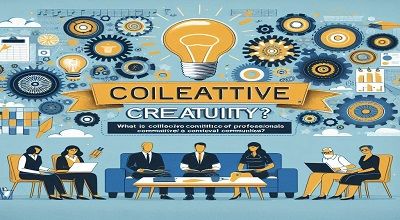Collective Creativity
Collective Creativity refers to the creative process that emerges when a group of individuals work together to generate, develop, and implement new ideas, solutions, or innovations. It is a collaborative approach to creativity, where multiple people contribute their insights, skills, and perspectives to solve problems or create something new. Collective creativity can be found in various contexts, including business, the arts, education, and scientific research.
Here are some key aspects of collective creativity:
Diverse Perspectives: One of the fundamental principles of collective creativity is that diverse groups of people bring different perspectives, knowledge, and experiences to the table. This diversity can lead to more innovative and well-rounded solutions.
Collaborative Problem-Solving: In a collective creativity setting, individuals collaborate to address complex problems or challenges. This collaboration often involves brainstorming, idea generation, and constructive feedback.
Idea Sharing: Participants openly share their ideas and insights, and these contributions are valued and built upon by others in the group. This open exchange of ideas can lead to the synthesis of novel concepts.
Iterative Process: The creative process in collective creativity is often iterative, involving multiple rounds of idea generation, refinement, and testing. This allows for the gradual improvement and development of creative solutions.
Teamwork: Effective teamwork and communication are essential for collective creativity. Groups must foster an environment where individuals feel comfortable sharing their thoughts and working together cohesively.
Innovation: Collective creativity can lead to the development of innovative products, services, or solutions that may not have been possible through individual efforts. It can result in breakthroughs and disruptive ideas.
Decision-Making: In some cases, collective creativity involves decision-making processes to select the best ideas or solutions from among those generated. This may require a fair and transparent evaluation process.
Characteristics of Professional Communities
Professional communities, also known as professional learning communities (PLCs) or communities of practice, are groups of individuals within a specific field or profession who come together to collaborate, share knowledge, and improve their skills and expertise. These communities serve various purposes and exhibit several key characteristics:
- Common Interest or Field: Professional communities are formed around a shared interest or a common professional field, such as education, healthcare, engineering, or technology. Members typically have similar goals or work in related areas.
- Collaborative Learning: Collaboration is a fundamental aspect of professional communities. Members work together to learn from one another, share experiences, and collectively improve their knowledge and skills. This often involves active discussions, problem-solving, and knowledge exchange.
- Mutual Support: Members of professional communities provide support to one another. This support can be emotional, informational, or practical. They may offer advice, share resources, or help each other overcome challenges.
- Shared Resources: Professional communities often maintain and share a repository of resources, which may include documents, best practices, research findings, and tools. These resources are valuable for members’ professional development.
- Continuous Learning: A commitment to lifelong learning and professional development is a hallmark of professional communities. Members engage in ongoing learning and seek to improve their skills and knowledge.
- Reflection and Feedback: Members engage in reflective practice, discussing their experiences and seeking feedback from peers. This reflective process helps individuals grow in their professions.
More here…
- Inclusivity and Diversity: Professional communities often welcome individuals with diverse backgrounds, experiences, and perspectives. This diversity can enhance the richness of discussions and problem-solving.
- Regular Meetings and Communication: Many professional communities have regular meetings, whether in person or online. These meetings facilitate knowledge-sharing, collaboration, and relationship-building among members.
- Shared Goals and Values: Members of professional communities typically share common goals and values related to their profession. These shared goals serve as a unifying force within the community.
- Leadership and Facilitation: Some professional communities have leaders or facilitators who guide discussions, ensure that meetings run smoothly, and help maintain a sense of purpose and direction.
- Commitment to Improvement: A commitment to improving professional practice is a driving force in these communities. Members are often motivated to enhance their skills and contribute positively to their respective fields.
- Professional Accountability: Professional communities can promote accountability among their members. This accountability may be related to meeting professional standards, adhering to ethical guidelines, or achieving certain outcomes.
- Adaptability: These communities are often adaptable and open to change. They evolve with the shifting needs and demands of their profession, embracing new techniques, technologies, and knowledge.
Summary
Collective creativity can take various forms, from brainstorming sessions in the workplace to collaborative artistic projects, research teams, and community initiatives. It is a powerful approach for tackling complex challenges and harnessing the collective intelligence of a group to generate creative solutions. However, it also comes with its challenges, such as managing group dynamics, ensuring equitable participation, and balancing diverse perspectives to reach consensus or make decisions.
Professional communities can exist in various settings, including within educational institutions, healthcare organizations, businesses, and online forums. They play a crucial role in fostering continuous professional development and improving practices within specific fields or industries.
